
From a run in Upper Las Virgenes Canyon Open Space Preserve (formerly Ahmanson Ranch) on October 12, 2006.

From a run in Upper Las Virgenes Canyon Open Space Preserve (formerly Ahmanson Ranch) on October 12, 2006.
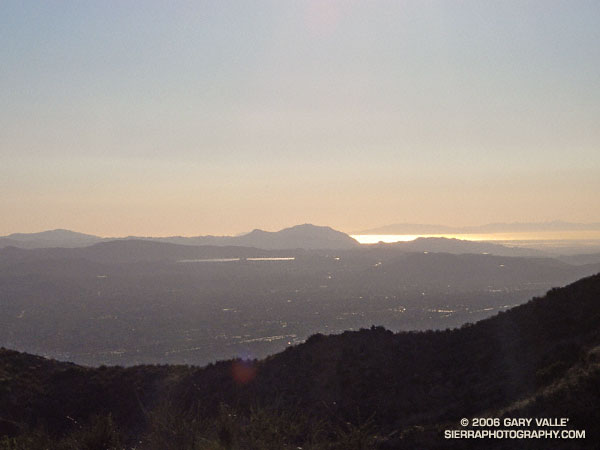
Simi Valley, Conejo Mountain, the Oxnard plain, Santa Barbara Channel, and the Channel Islands from the Chumash Trail.
Conejo Mountain is about 21 miles away, and the nearest point on Santa Cruz Island is about 50 miles distant.
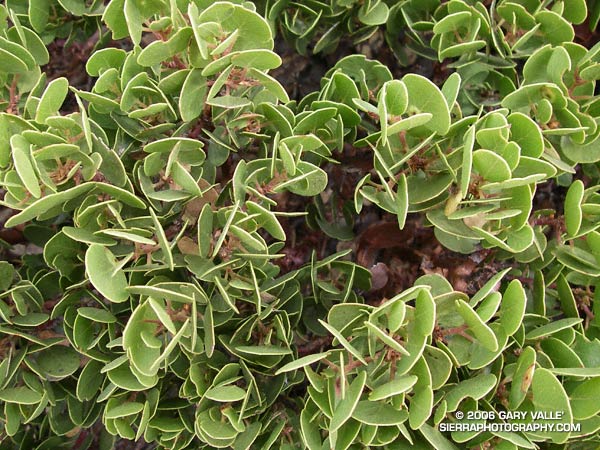
Peculiar pattern in low lying manzanita on the south slopes of Pine Mountain. A friend noted the remarkable similarity of this pattern to that found in gypsum crystals in a desert rose. From the Mt. Baldy North Backbone Trail run/hike.
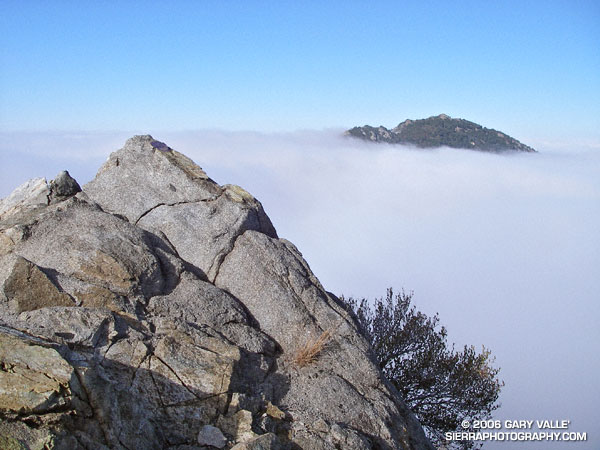
When I broke through the top of the stratus layer, bright sun glared from the jagged granitic rocks along the ridge. To the west, Josephine Peak (5558′) was nearly immersed in an ocean of clouds.
The route I was doing was a variation of the Strawberry Peak Circuit described in the posting Spring Growth. Instead of going around the peak on the Colby Trail, this 13-mile loop climbs up and over Strawberry’s summit (6164′), ascending the class 3 northwest ridge, and then rejoins the circuit at Lawlor Saddle. Although a couple of miles shorter than the circuit around the peak, this route has more elevation gain, and the class 2 and class 3 sections of the ridge require careful route-finding.
Class 2, class 3 – what’s that about? Basically, class 1 is hiking, class 2 is easy scrambling where the hands are used for balance, and class 3 is when the scrambling gets serious, and handholds are required. Another element of class 3 climbing is that staying on route can be important. Deviating from an established route may significantly increase the difficulty or hazard. This is certainly the case on the northwest ridge of Strawberry.
Like much of the San Gabriel Mountains, the rocks of Strawberry Peak are old and fractured. Large landslides have originated from the northwest face of the peak. (The Colby Trail passes through the moraine-like debris of one of these slides.) Because of its friable nature, extra care is required when climbing the northwest ridge. Hand or footholds can break, or footing can be lost on a sandy shelf. Or, as described in a story by pioneering aerodynamicist Paul MacCready, the climber can be trapped in a situation where they cannot climb up or down.
The northwest ridge of Strawberry is by far the most frequently climbed class 3 route in the San Gabriel Mountains. Done with care and appropriate skill, the climbing on the ridge can be an enjoyable and unique experience.
On the summit ridge, I admired the steep northwest face of Strawberry Peak as it plunged through the morning shadows to Strawberry Potrero nearly 1500′ below. Did I hear voices down there, or was it just the wind…
Here are a Google Earth image and Google Earth KMZ file of a GPS trace of the route.
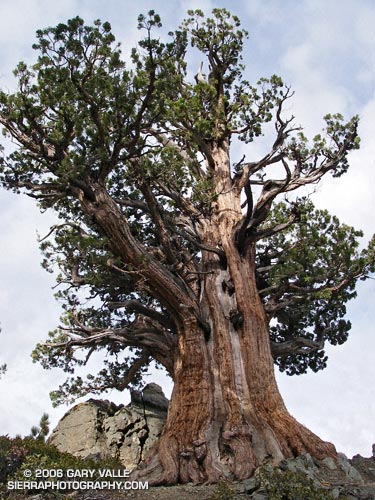
Updated September 19, 2010.
This Sierra Juniper (Juniperus occidentalis var. australis) resides at an elevation of 9000′ on the rocky slopes of Pine Mountain in the Sheep Mountain Wilderness of Southern California. It is an impressive and aged tree. The question is, how old might it be?
Junipers are very slow growing and seem to prefer the dry and difficult conditions that can produce very long-lived trees. Two junipers more than 2000 years old are listed in OLDLIST, a database of scientifically supported tree ages maintained by Rocky Mountain Tree-Ring Research, Inc.
Both of these trees are located in the Sierra near Sonora Pass. OLDLIST lists the age of the Bennett Juniper, a living tree, at an extrapolated age of 2200 years. This estimate is based on a crossdated incremental core. The Scofield Juniper, a tree that died in 1165, has been crossdated at an age of 2675 years.
The Bennett Juniper is a massive tree. The National Register of Big Trees lists its circumference at 481 inches, and height at 78 feet. The juniper on Pine Mountain is not nearly as large, but it is still a sizeable tree.
Update 9/19/2010. I measured the circumference of the Pine Mountain juniper at 14′ 6.5″ or 174.5 inches. This works out to an average diameter of 55.5 inches. The tree is more or less elliptical in cross section, with the major axis aligned along the ridgeline. The tree’s diameter along the major axis is estimated to be 65-70 inches.
If the Bennett Juniper’s diameter is about 153 inches and its age is 2200 years, its average growth in diameter would be 0.0695 inch a year. Applying this same growth rate to the average diameter of the Pine Mountain tree, and its estimated maximum diameter, yields an age range estimate of 800 to 1007 years.
But relative size may not be indicative of relative age. The Pine Mountain Juniper’s shorter rain season and rocky, ridgetop location likely resulted in a slower growth rate than the Bennett tree. The Wally Waldron Limber Pine on nearby Mt. Baden-Powell is estimated to be 1500 years old, and some other Limber Pines on Baden-Powell are thought to be 2000 years old. Whatever its exact age the Pine Mountain Juniper is an extraordinary tree.
The photographs in this post (except for the Wally Waldron tree) were taken on the Mt. Baldy North Backbone Trail and North Backbone Trail Revisited run/hikes.
Some related posts: Inspiration Point to the Pine Mountain Juniper, Mt. Baldy Run Over the Top
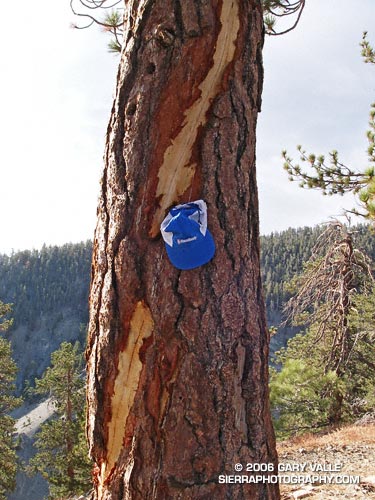
Mt. Baldy’s North Backbone Trail is not a place to be in a thunderstorm. From start to finish it seems you are either on the crest of a ridge, or on or near the summit of a peak.
The photo above is of a spiral lightning scar on a Jeffrey Pine on the trail at the summit of peaklet marked 8555 on the USGS Mount San Antonio quad. The scar appears to be fresh, and could be from a strike that occurred this Summer. Perhaps the most remarkable thing, given the tree’s prominent location, is that it hasn’t been struck and scarred before.
The photographs are from Sunday’s North Backbone Trail Revisited hike and run. A photograph of another Jeffrey pine that was struck by lightning can be found in the post Three Points – Mt. Waterman Loop.
Google search: $g(lightning), $g(Jeffrey Pine), $g(lightning tree), $g(North Backbone Trail), $g(Mt. Baldy)